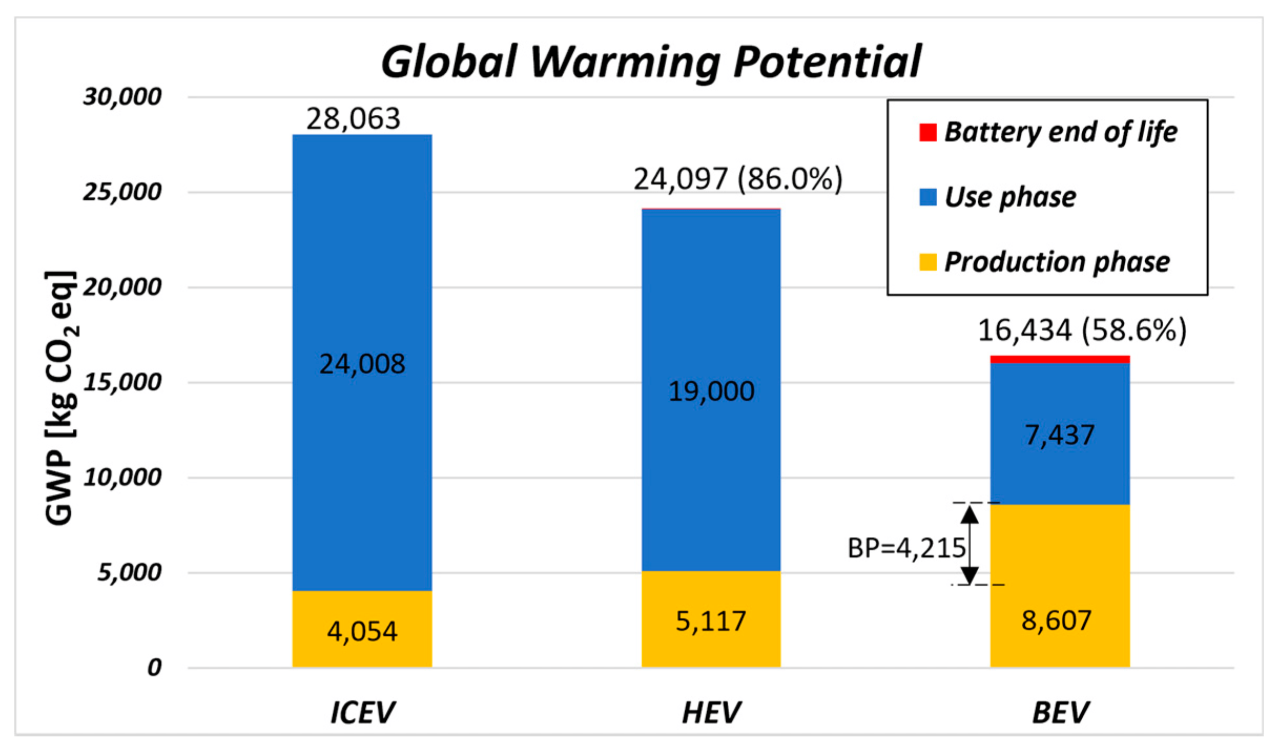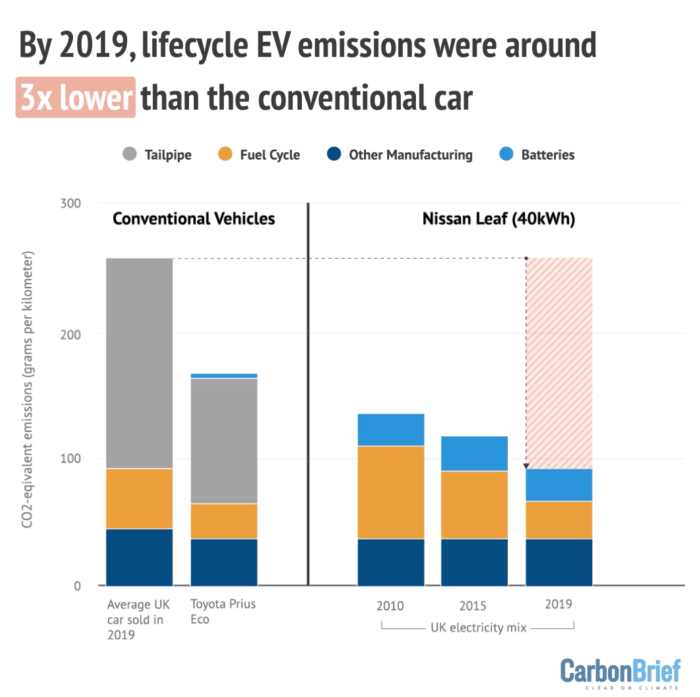With Environmental impact of traditional vs. electric cars at the forefront, this paragraph opens a window to an amazing start and intrigue, inviting readers to embark on a storytelling filled with unexpected twists and insights. Traditional cars have long been the standard mode of transportation, but the rise of electric vehicles is changing the game. Let’s delve into the environmental implications of these two contrasting technologies.
We will explore how the manufacturing processes differ, the energy sources powering each type of vehicle, the pollution and emissions they produce, and the overall lifecycle impact. By the end of this discussion, you’ll have a comprehensive understanding of the environmental footprint of traditional versus electric cars.
Environmental impact of traditional vs. electric cars

When it comes to the environmental impact of traditional cars versus electric cars, the manufacturing process plays a crucial role in determining the overall carbon footprint.
Curious about the latest electric cars with cutting-edge technology? Get the scoop on the most anticipated models in this Upcoming electric cars with cutting-edge technology article. Stay ahead of the curve and see what the future of driving looks like!
Manufacturing Process of Traditional Cars
The manufacturing of traditional cars involves extracting raw materials like steel, aluminum, and plastic, leading to deforestation, habitat destruction, and increased greenhouse gas emissions. The assembly process further adds to the environmental impact through energy-intensive production methods.
Production of Electric Cars
On the other hand, electric cars are manufactured using cleaner energy sources and materials, reducing the carbon footprint significantly. The production of electric cars emits fewer greenhouse gases and pollutants compared to traditional vehicles.
So, you’re looking for the best car detailing products out there? Look no further! Check out this Car detailing products review to find out which ones will give your ride that showroom shine you’ve been dreaming of.
Emissions Over Lifespan
Over the lifespan of a vehicle, traditional cars emit a substantial amount of greenhouse gases and pollutants through fuel combustion, contributing to air pollution and climate change. In contrast, electric cars produce zero tailpipe emissions, promoting cleaner air quality and a lower overall impact on the environment.
Key Components in Traditional Cars
- The internal combustion engine in traditional cars releases harmful emissions like carbon dioxide, nitrogen oxides, and particulate matter, contributing to global warming and air pollution.
- The use of fossil fuels in traditional cars further exacerbates the environmental impact by depleting natural resources and emitting greenhouse gases.
- The disposal of batteries and other toxic components in traditional cars poses environmental risks, leading to soil and water contamination if not handled properly.
Energy consumption and sources

Electric cars and traditional vehicles have distinct differences in energy consumption and sources. Let’s delve into the details to understand the environmental impact of each.
Energy Consumption Differences
When it comes to energy consumption, traditional cars rely on internal combustion engines that burn fossil fuels like gasoline or diesel. This process generates emissions that contribute to air pollution and climate change. On the other hand, electric cars use electricity stored in batteries to power an electric motor, producing zero tailpipe emissions. This key difference highlights the environmental advantage of electric vehicles in terms of energy consumption.
Sources of Energy for Traditional Cars
Traditional cars predominantly rely on fossil fuels like gasoline and diesel, which are finite resources extracted through drilling and mining processes. The combustion of these fuels releases carbon dioxide and other pollutants into the atmosphere, contributing to global warming and air quality issues. The environmental implications of using fossil fuels for transportation are significant, driving the need for cleaner alternatives.
Sources of Energy for Electric Cars, Environmental impact of traditional vs. electric cars
Electric cars are powered by electricity, which can be sourced from various energy generation methods. While some electricity is still produced from fossil fuels, an increasing amount comes from renewable sources like solar, wind, and hydropower. This shift towards cleaner energy sources enhances the environmental benefits of electric vehicles, reducing greenhouse gas emissions and promoting sustainability.
Overall Energy Efficiency
In terms of overall energy efficiency, electric cars have the upper hand over traditional vehicles. Electric motors are significantly more efficient than internal combustion engines, converting a higher percentage of energy from the source to power the vehicle. Additionally, the growing use of renewable energy sources for electricity generation further improves the energy efficiency and environmental performance of electric cars.
Pollution and emissions: Environmental Impact Of Traditional Vs. Electric Cars

When it comes to pollution and emissions, traditional cars have a significant impact on the environment. The combustion of gasoline or diesel in internal combustion engine vehicles releases harmful pollutants into the air, contributing to air pollution and climate change.
Types of emissions from traditional cars
Traditional cars emit various types of pollutants, including:
- Carbon monoxide (CO)
- Nitrogen oxides (NOx)
- Particulate matter (PM)
- Hydrocarbons (HC)
- Carbon dioxide (CO2)
These emissions have a detrimental impact on air quality, leading to smog, respiratory issues, and other health problems in humans and animals.
Impact of electric cars on reducing pollution
Electric cars, on the other hand, produce zero tailpipe emissions. They run on electricity stored in batteries, which means they do not release harmful pollutants into the atmosphere during operation.
- Electric cars help reduce pollution levels, particularly in urban areas where air quality is a major concern.
- By switching to electric vehicles, we can significantly decrease the amount of harmful emissions released into the air, thereby mitigating the effects of climate change and improving public health.
Emission reduction potential of electric vehicles
Studies have shown that the widespread adoption of electric vehicles could lead to a substantial reduction in greenhouse gas emissions and air pollutants.
According to the U.S. Department of Energy, electric vehicles produce lower emissions than gasoline-powered cars, even when accounting for electricity generation from coal-fired power plants.
Lifecycle analysis
Electric vehicles (EVs) and traditional internal combustion engine vehicles (ICEVs) have different environmental impacts throughout their lifecycle. Let’s analyze the overall sustainability aspects of both types of vehicles.
Manufacturing Phase
The manufacturing phase of EVs typically has a higher environmental impact compared to ICEVs due to the production of batteries and other components. The mining of materials for batteries, such as lithium and cobalt, can lead to land degradation and water pollution. However, advancements in sustainable manufacturing practices are being made to reduce these impacts.
Usage Phase
During the usage phase, EVs have a significantly lower environmental impact compared to ICEVs in terms of emissions and pollution. EVs produce zero tailpipe emissions, reducing air pollution and greenhouse gas emissions. This results in overall lower environmental impact during the operational lifespan of the vehicle.
End-of-Life Phase
When it comes to end-of-life considerations, both EVs and ICEVs face challenges in recycling and disposal. The recycling potential for EV batteries is increasing, but there are still challenges in recycling lithium-ion batteries efficiently. ICEVs also have recycling challenges with components such as lead-acid batteries and engine parts. Proper disposal and recycling practices are essential to minimize the environmental impact of both vehicle types.
Long-Term Sustainability
In the long term, the sustainability of EVs is promising as advancements are made in battery technology, recycling methods, and renewable energy sources. As the electricity grid becomes greener and more renewable energy is used for charging EVs, the overall environmental impact of electric vehicles is expected to improve. ICEVs, on the other hand, face challenges in reducing emissions and becoming more sustainable in the long run.
Closing Notes
In conclusion, the comparison between traditional and electric cars reveals significant differences in their environmental impact. While traditional cars have a long history of contributing to pollution and resource depletion, electric cars offer a more sustainable alternative. As we move towards a greener future, understanding these differences is crucial in making informed decisions about our transportation choices.